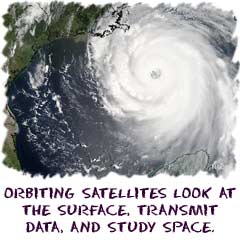|
|
||||||||||||||||||||||||||||
 |
|

|
||||||||||||||||||||||||||
Circling the Earth Let's start by saying that there are satellites that orbit the Earth. They are unmanned and do not leave the orbit of the Earth. The first satellite launched into space was Sputnik in 1957. Sputnik was only a tiny metal ball that transmitted a signal for about three weeks. It wasn't until 1962 that the first orbiting satellite provided long-term service to the Earth. That satellite was named Telstar.
Let's start by saying that there are satellites that orbit the Earth. They are unmanned and do not leave the orbit of the Earth. The first satellite launched into space was Sputnik in 1957. Sputnik was only a tiny metal ball that transmitted a signal for about three weeks. It wasn't until 1962 that the first orbiting satellite provided long-term service to the Earth. That satellite was named Telstar.
Advanced SystemsAfter the initial launches, the number of satellites and their complexity has continued to increase. Today there are thousands of man-made objects orbiting the Earth. If you go outside on a very clear night, there is a good chance you will see a bright light speed across the sky. These fast moving objects are often satellites that are reflecting the light of the Sun.Many of the first communications satellites were developed by the Hughes company. Those early systems rebroadcast television signals and millions of phone calls. As time passed, that system of satellites became the satellite television system known as DirectTV. There are geostationary satellites that are positioned above North America that transmit television signals to the receiving dishes located on people's houses. Different OrbitsEvery satellite has a unique orbit. These specific orbits are set up so that they don't hit each other as they travel through space. Companies and governments have invested millions of dollars into each satellite and it would be very expensive to replace them. There are also different types of orbits for satellites. The four types of orbits you may read about are low earth orbit (LEO), geosynchronous equatorial orbit (GEO), and extreme elliptical orbits. There are different classifications for each of these and you may hear the terms MEO, polar, or HEO. Here's a quick breakdown:Elliptical Orbit: An orbit that is similar to a polar orbit in that the spacecraft moves in a North-South direction. The orbit is also similar to a HEO orbit because of the path of the spacecraft. Low Earth Orbit: LEO. An orbit that is not larger than 2,000 kilometers from the surface of the Earth. Geosynchronous Equatorial Orbit: GEO. An orbit that can be set at a few hundred or several thousand kilometers above the surface. The spacecraft orbits above a general point and can be found in a regular position above the surface. Polar Orbit: An elliptical orbit that takes the spacecraft over the poles of the planet. This is often a specific type of LEO that takes the spacecraft in a North-South direction. Highly Eccentric Orbit: HEO. An elliptical orbit that takes a spacecraft as close as 1,000 kilometers from Earth and as far as 10,000 kilometers away. Medium Earth Orbit: MEO. A non-geosynchronous orbit at about 10,000 kilometers from the surface. |

|
|||||||||||||||||||||||||||
Useful Reference MaterialsEncyclopedia.com:http://www.encyclopedia.com/topic/Satellite.aspx Wikipedia: http://en.wikipedia.org/wiki/Satellite Encyclopædia Britannica: http://www.britannica.com/EBchecked/topic/1469543/satellite | ||||||||||||||||||||||||||||
|
RETURN TO TOP or Search for more information... * The custom search only looks at Rader's sites. |
|||||||||||||||||||||||||||
©copyright 1997-2015 Andrew Rader Studios, All rights reserved. Current Page: Cosmos4Kids.com | Space Exploration | Satellites |
||||||||||||||||||||||||||||
|
|
||||||||||||||||||||||||||||

